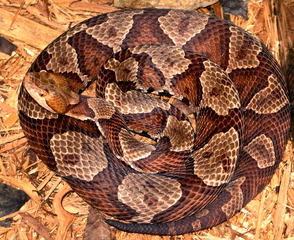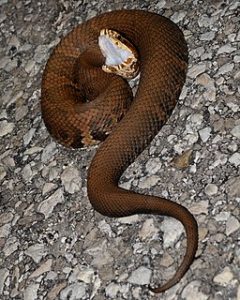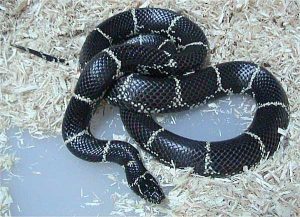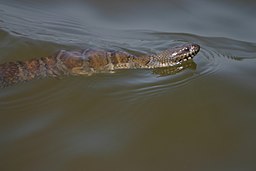Virginia’s temperate climate, warm summers, and forests filled with animal life make it a home for many snakes. Snakes are carnivorous reptiles that evolved from lizards at some point in the Mesozoic, and, like lizards, they are cold blooded. Though Virginia’s winters are too cold for them to be active, many snakes are active up until the end of October, so there’s a long window of time you might encounter them in the outdoors. Most snakes in Virginia, and all but one species in the Fredericksburg area, are non-venomous and don’t pose a danger to humans. But be careful, because that one venomous species, the copperhead, is very common. Learning about the different snakes of Virginia can help you control pests in your backyard, protect the environment, and keep you safe.
Books on snakes and other reptiles, especially the species you'll find here!
Danger in the Grass: Venomous Snakes in Virginia

The Fredericksburg area’s venomous snake species is not particularly aggressive but can still be dangerous to those who are careless and unaware of their surroundings. The copperhead is a pit viper with a tan body, covered in diamond shaped rust-colored bands. The body of the copperhead is very hard to distinguish from wood and dead leaves, and many bites occur during fall as a result. They are very slow-moving snakes that rely on their camouflage to catch small mammals, such as mice, rats, and voles. Copperheads are not very nervous snakes and typically only react to humans when they come very close. They will often “freeze up” and become motionless rather than trying to frighten the human away or fleeing, only biting once physically touched. If you do get bit, opens a new window, you will need to go to a hospital and may require antivenom, which can be expensive. Be careful, watch where you walk, and always wear enclosed shoes while outdoors.
A few more facts can help you avoid a painful encounter with a copperhead. Young copperheads are sometimes mistaken for a different type of snake because of their bright yellow tail, opens a new window, but are just as venomous as adults and should be avoided. Copperheads also change the time of day they are active depending on the season, coming out at night during the hot summer months, but preferring day activity in the spring and fall. Be very careful when working with leaf piles up until the end of October! Above all, leave the copperheads alone whenever possible; attempting to move or kill them will most likely result in you getting bit, and they control the rodent population.

If you travel outside the Fredericksburg area, you may encounter Virginia’s other two venomous snakes. The cottonmouth favors hotter, wetter conditions than those of the Fredericksburg/Rappahannock area, mainly living south of the James River. It is similar in shape to the copperhead but has a darker brown/black body and is longer than its close relative. It often hunts in the water and is named for the bright white mouth it displays as a warning when provoked. The timber rattlesnake, unlike the other two venomous snakes of Virginia, is quite rare. It only appears in the Appalachian Mountains in the west of Virginia and a very small area in the southeast part of the state. The southeast population is so small, they are considered a state endangered species. All of Virginia’s venomous snakes are vipers, and, if you are bitten by any of them, you will receive the same antivenom, CroFab.
Natural Allies: Non-Venomous Snakes in Virginia
There are many species of non-venomous snakes in Virginia, and they are all harmless to humans and important for pest control. One common non-venomous snake in the Fredericksburg area is the black racer. Black racers are shiny, all-black snakes that are often found in grassy fields and areas close to lakes and rivers. They are active only during the day and are known for their frequent movement to evade predators. They hunt a variety of small animals, such as frogs, moles, rodents, and lizards, and pin their prey to the ground while attempting to swallow it rather than constricting it. Black racers are very nervous snakes that will rapidly flee if you move close to them. Sometimes they are killed because people mistake them for a venomous snake. Their black body may convince people they are a cottonmouth (which don’t live in Fredericksburg), and they will also make a rattlesnake-like noise from their tail if cornered. Unlike those snakes, the racer moves extremely fast and will always flee until there is no other option, so let it escape!

Another non-venomous snake you may see in the Fredericksburg area is the eastern kingsnake. Eastern kingsnakes in the Fredericksburg area have a black body with thin white bands. These snakes are not hostile to humans and have a relaxed personality, making them a favorite among pet snakes. You should leave wild ones in their own environment though, as they have a very important ecological role to play. A large part of the eastern kingsnake’s diet is other snakes, including venomous ones like copperheads. Wild kingsnakes are much needed to control our copperhead population.

There are several other types of non-venomous snakes in the Fredericksburg area that you may encounter. The most common of these is the garter snake, making its home in many backyards. Garter snakes are thin yellow and green snakes that are harmless to humans and eat mainly frogs. Another non-venomous snake in our area is the eastern hognose snake. This snake is sometimes mistaken for a venomous snake and killed because of its broad, flat head and hissing response to human approach, but it is not dangerous to people. It can always be identified by its pig-like, upturned snout. A non-venomous snake you might find in the Rappahannock or other lakes and rivers of our area is the northern watersnake. This snake typically hunts along the edges of lakes and rivers and eats mostly fish. It has a long, thin body and will flee at the approach of humans. Though the watersnake is one of the larger and more intimidating snakes in our area and sometimes confused with a cottonmouth, it is harmless to humans and best left alone.
Don’t Abandon Your Reptile Pet!
Many people enjoy keeping non-venomous snakes as pets. Typically, these are smaller snakes that are easier to keep and feed, and species with calm temperaments are preferred. The ball python and the corn snake are two snakes that are popular as pets. Keeping a larger snake, such as a Burmese python , opens a new windowor reticulated python, can be very expensive and is not recommended for most people. These large snakes can also pose an additional risk to the environment that smaller native snakes, such as the corn snake or kingsnake, do not.
Some would-be pet owners do not realize how large reptiles such as the Burmese python or the Argentine tegu lizard can grow. Reptiles hatch from small eggs, and the babies and juveniles look like they can easily be maintained by even an amateur pet owner. But in species such as the Burmese and reticulated pythons, the growth continues, surprising the owner as the animal continues to grow larger, hungrier, and more expensive. A selfish pet owner may simply abandon the pet once it grows past a certain size, but this can pose a major threat to the environment. Populations of Burmese pythons and tegus have become invasive species in states such as Florida and Georgia, threatening the native wildlife, and the threat posed by abandoned or escaped reptile pets may increase over time in Virginia. Be sure to research any reptile pet you may purchase, avoid large species, and don’t abandon your pets.

